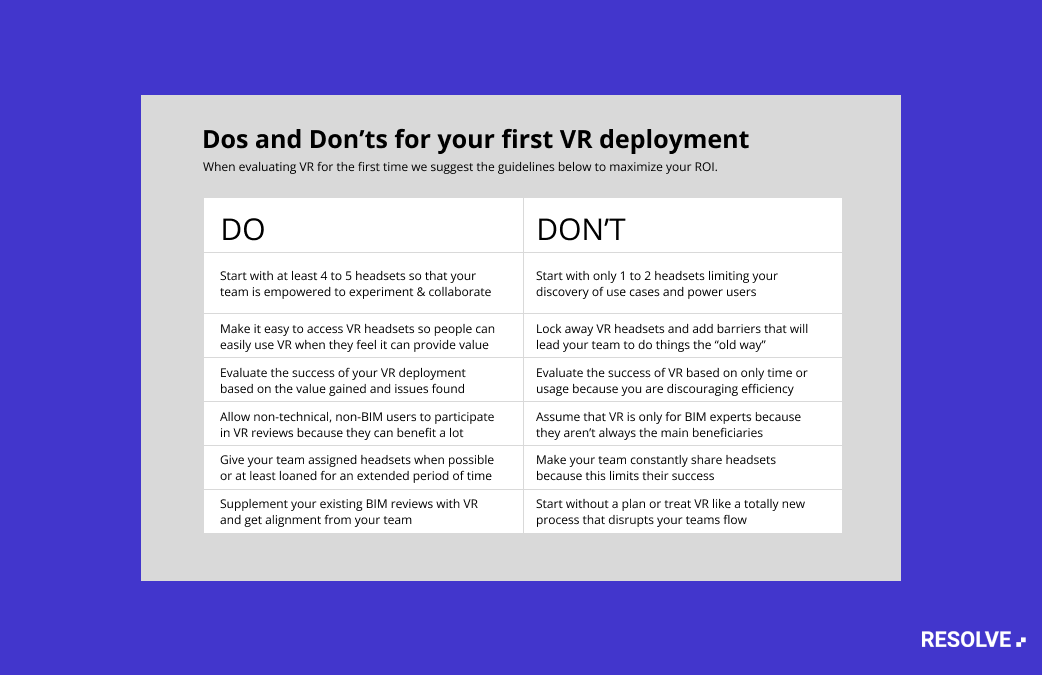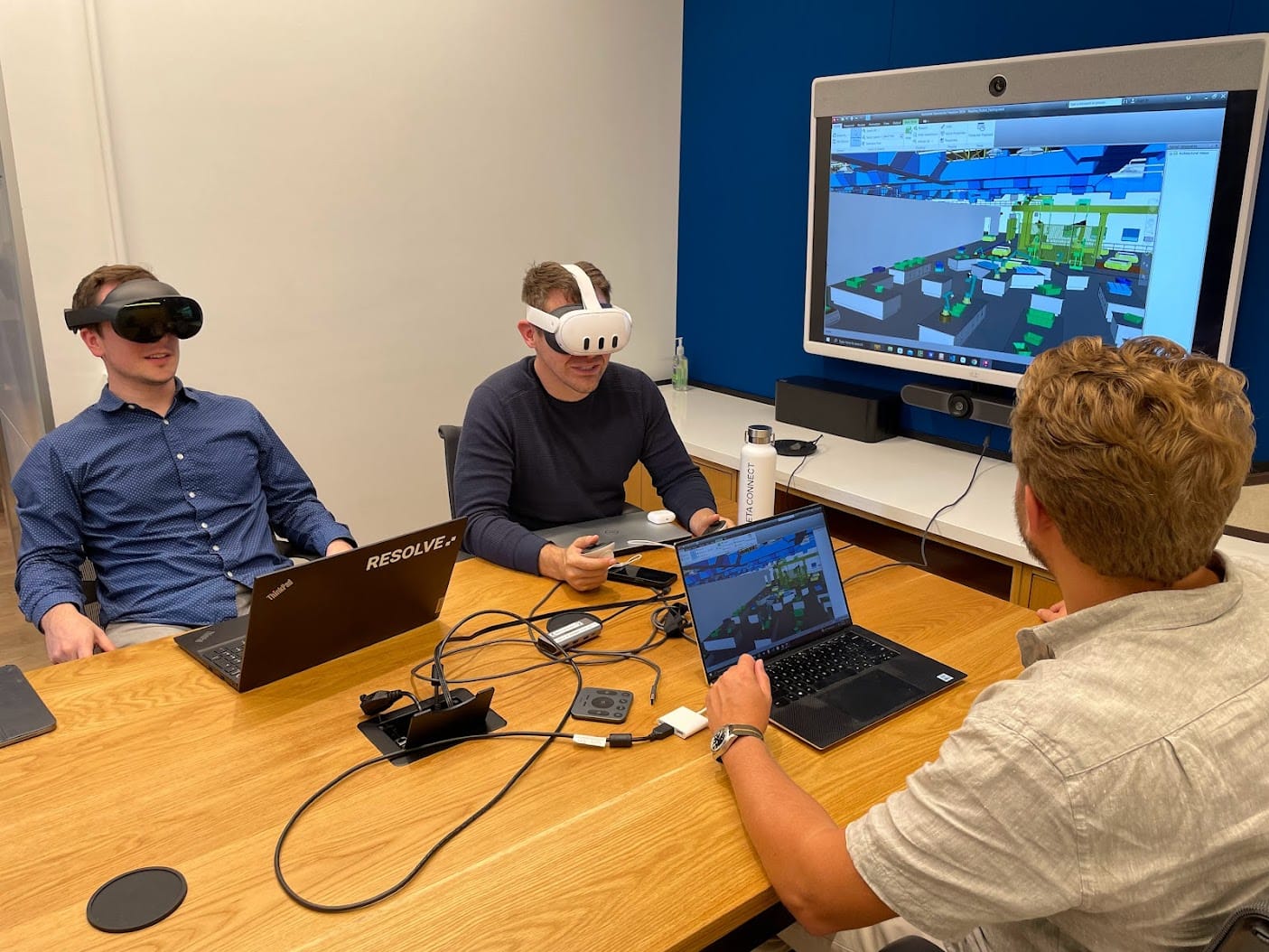More VR headsets = more ROI
Larger VR headset deployments for BIM review can be intimidating, but they set organizations up for success. More headsets mean more access to BIM, and that leads to more ROI.
Larger headset deployments can be intimidating, but they set organizations up for success. More headsets mean more access to VR, and that leads to more ROI.
It's a familiar predicament for many new Resolve customers: You are deploying VR for the first time, it's a new technology and you're not sure how your team will take to it. You want to dip your toes in the water: Why not buy one or two headsets and make them available for your team to check out and share when they need them?
This sounds like a good way to test VR, but starting too small almost always hampers the success of the VR deployment.

Reduce the physical barriers to adoption
Having only one or two headsets locked away and requiring check-out adds to the sense that VR is a specialized tool, and creates an unnecessary barrier for people who want to begin experimenting with the technology.
Requiring that headsets be checked out reduces the chances of creating new VR champions. Team members may want to use VR, but be put off by the need to submit an IT ticket or ping someone to unlock the VR drawer for them.
Empower curiosity and find power users
With Resolve, VR is not just for BIM and VDC experts. Resolve revolutionized 3D model review in VR when we released our Wellington Engine, which allows users to render and review massive 3D files on untethered headsets. Resolve democratizes model review by allowing your organization to get more eyes on 3D models. Reviewers can find and resolve more issues, faster.
Starting your VR deployment with only one headset limits who can tap into the power of VR. Time and time again, Resolve customers have found that some of VR's biggest advocates are those they didn’t expect. In fact, those most unfamiliar with BIM stand to gain the most from reviewing BIM in VR, as the intuitive feel of the tool makes 3D models easier to understand and review.
More headsets means a more comprehensive review process, which will lead to a faster and bigger return on your team's investment in VR.
VR Headsets quickly pay for themselves
The average Resolve user more than recovers the cost of a headset as soon as they find one issue that would have resulted in an RFI
We hear some typical objections when we dissuade teams from a small headset deployment:
- The cost of additional headsets
- Headsets will only be used infrequently by reviewers, like at project milestones
- You're not sure how much demand there will be for VR
- You've worked with shared headsets or in a VR cave in the past

While the cost of additional headsets should always be considered, Meta's Quest 3 headset now costs under $500 and delivers many capabilities that were previously reserved for more expensive devices. According to Navigant, the average administrative overhead of an RFI is $1,080, meaning the average Resolve user more than recovers the cost of a headset as soon as they find one issue that would have resulted in an RFI. In 2023, each active Resolve user found an average of 8 issues in VR.
Regarding the frequency of headset use, headsets can be used as frequently as your team deems necessary, but we ultimately advise that they be used to augment existing model review processes. Depending on the audience, this may mean that some users only sign into their headsets on a periodic basis. That said, the cost of VR shouldn't be assessed on a "per use" basis, it should be analyzed on an "issues found" basis. In fact, one of the best reasons to use VR is that it will require less time overall than 2D screen review to find issues, freeing up time for your team to focus on higher-impact project delivery tasks.
Sharing headsets dilutes your ROI
We acknowledge that VR is a relatively new technology for AEC, and this may generate doubts about the demand for the tool within your teams. Ultimately, however, forcing reviewers to share headsets creates a self-fulfilling prophecy regarding demand for VR.
Forcing reviewers to share headsets to access VR creates friction which encourages them to review on 2D screens. Don't push your employees to say "but this is the way we've always done it".
Set your teams up for success
For those who have past experience with VR, you may be familiar with shared headsets or VR caves, but are you sure that those were effective solutions? Project teams using VR have saved up to $3 million in rework on a single project by using Resolve. To do this, a wide range of stakeholders participated in review, often in free moments by picking up their headsets for ad-hoc reviews. This type of impactful deployment simply isn't possible when teams have to check out headsets or travel to a VR cave. You wouldn't ask your team to share laptops or phones, so why ask them to share headsets?

If we've convinced you to consider a larger headset deployment, you may be wondering where to start. The first step before any deployment of VR is to get a clear idea of what is being reviewed, and by whom. Ideally, any team member who would be tasked with reviewing a 3D model should be assigned a headset. Practically, we understand that cost considerations may prevent this, so we suggest that customers looking to cut hardware costs select VR champions in each relevant group (e.g. mechanical, civil and electrical engineering, health & safety, operations, maintenance, etc.).
Regardless of how many are purchased, before deploying headsets reviewers, the team should work with Resolve to develop a VR review workflow, present it to the team and get commitment on the use of VR.
Do you want to upload your own BIM to review in VR? Sign up for a free trial.
Resolve builds software that makes 3D building information models more accessible so teams can find critical issues that save time and money on new construction. Resolve's Wellington Engine can render large BIM files on the standalone VR devices making it a scalable, easy to use solution for project teams. Resolve is used by leaders spanning industries like food & beverage, water treatment, data centers, biopharmaceuticals, and green energy.
